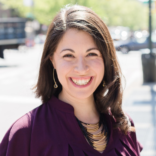(JTA) — On March 13, nearly a year to the day after Temple Beth El of Charlotte, North Carolina, closed due to COVID-19, Rabbi Dusty Klass gathered the congregation’s 900 households for a shared — albeit remote — Jewish experience.
Unable to gather her community for worship, Klass and her colleagues, including operations manager Nathalie Friedlander, invented something new: Challah Day. Volunteers baked over 900 challahs, and others delivered them to the doorstep of every household in the community for enjoying over a Shabbat meal.
Even those who rarely attend synagogue participated. New volunteers took leadership roles; people of different ages and stages initiated new relationships; those who felt only a distant connection to the community and to Jewish practice reported a sense of belonging.
Klass was one of thousands of pulpit rabbis who amid the pandemic quickly became rabbinic entrepreneurs — and in the process kindled new energy in her Jewish community.
“I don’t know what to say except that the worst misfortune isn’t only misfortunes,” says the Rev. John Ames, a character in Marilynne Robinson’s novel “Gilead.” These words are true of the impact that COVID-19 has had on the rabbinate. Our clergy have now spent more than a year adapting their leadership to reach beyond their synagogue walls, serving those who couldn’t show up.
Misfortune may have fully emptied our sanctuaries, but the pandemic was merely an acceleration of a trend. The 2021 Pew Study of American Jews demonstrated that even before the pandemic, 52% of American Jews reported attending synagogue “seldom or never.” Without a synagogue, most do not have a relationship with a good rabbi.
Yet more than half of these “non-attenders” reported “other ways of expressing their Jewishness” through, as Pew confirmed, “holidays, food choices, cultural connections or life milestones.”
Of course, there are thriving synagogues where clergy and congregants express a dynamic American Judaism. But the title “rabbi” no longer guarantees pews full of Jews. Largely trained and paid to serve synagogues, rabbis thereby don’t reach the Jewish majority.
Our clergy are an underleveraged resource in connecting Jews and Judaism — and can do so with the incentive and tools. COVID-19 has proven our rabbis are ready to radically change in order to reach our people where they are.
For the past several years, the Center for Rabbinic Innovation has been training rabbis with the skills they need to build new communities in our Fellowship for Rabbinic Entrepreneurs. We have had success training our clergy to build and lead Jewish communities with and for those who do not attend synagogues. It only takes relatively small investments and support to encourage this success.
I see this in our fellow Rabbi Ariel Root Wolpe, who is building Ma’alot Atlanta, an emergent spiritual community that gathers folks to “sing, hike, eat, and celebrate holy moments.”
While bringing rabbinic wisdom and spiritual leadership to this community, she has also been honing and practicing her entrepreneurial skills. Wolpe has met with scores of Atlanta residents who don’t attend synagogue. She has collected and analyzed data on their spiritual and communal needs, tested new ideas, tweaked her early projects and has begun to attract financial support for her work. Over this past year, with training and very modest investment in her work, her community has been growing.
Clergy in our fellowship learn the skills of spiritual entrepreneurship and practice a lean startup methodology. They use small launch funds to pilot projects meeting people where they are and move forward with them. Through the failures and successes of our rabbinic innovators, we are learning in real time the best practices for creating sustainable communities with those who seek to express Jewishness outside the synagogue.
This year, we extended our work to 150 intrepid rabbis, including Klass, who participated in our Rabbinic (re)Design Labs. These mid-career clergy, serving existing communities, transformed their own spiritual leadership.
For example, the rabbi of a midsize congregation launched a listening campaign, training a core of passionate volunteers to reach out and build deep connections to others within and outside the synagogue. With online meetings, they engaged more of their community than they had through regular synagogue programs and built Jewishly inspired, collaborative projects to overcome near-universal feelings of isolation.
Another rabbi in an urban congregation turned their neighborhood into a “Living Torah Museum Walking Tour” for Simchat Torah and beyond. They placed 54 laminated posters on members’ buildings and gates around their neighborhoods. Each poster had artwork representing one of the 54 weekly Torah portions, plus a QR code with links to the portion. Members, neighbors and curious passers-by all engaged with Torah in new ways.
These rabbis nearly universally said they could prioritize these innovative projects only because their regular synagogue services and programming were on hold.
The majority of clergy earn their salaries from institutions supported by and focused on their members. Necessarily, the bulk of their attention goes to serving the needs of those paying dues: sanctuary worship, b’nai mitzvah, synagogue-based Jewish education, social action and chesed initiatives. Already working to capacity, they have little time or resources to reach those who may never appreciate these synagogue functions. Only a small subset of clergy can take the financial risk to pursue their innovative ideas as entrepreneurs. And who pays the rabbi as she builds a spiritual startup?
Our entire community must radically invest in the reinvention of the rabbinate so that 1,500 rabbis, not 150, learn and practice these methods. Even as we rightly celebrate the reopening of our sanctuaries, now is the time to ask how your synagogue, JCC and federation are prioritizing and dedicating time and money to rabbinic innovation.
Training and supporting our clergy to lead successfully beyond the walls of the synagogue has exponential return on investment. COVID-19 has proven that they have the vision and capability to do so with the right training and support. Now is the moment to ensure that our clergy have the training, incentives, support and resources to harness this positive momentum born out of our misfortune.





